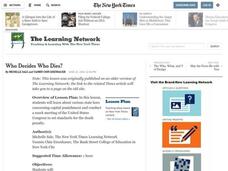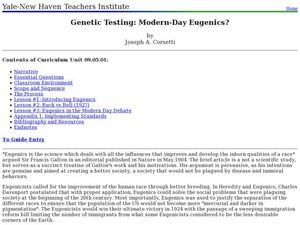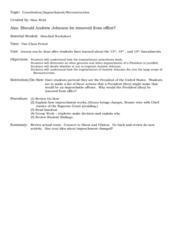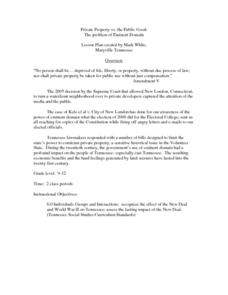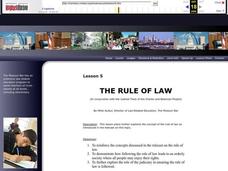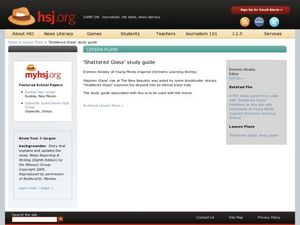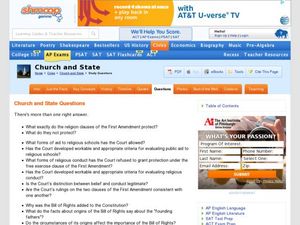ProCon
Gay Marriage
The first legal gay marriage in the United States occurred in Massachusetts in 2004. Since then, countless others have tied the knot. Scholars decide whether gay marriage should be legal by reading a history of the issue, analyzing the...
ProCon
Gun Control
According to some estimates, there are more guns than people in the United States. Learners decide if America should enact more gun control laws. They analyze information about gun deaths in the United States by year, read about the...
Curated OER
The First Amendment: What's Fair in a Free Country
Students describe the contents of the First Amendment while telling about an example of speech that is protected by the Constitution and that which is not. They attempt to apply the First Amendment to situations that could occur in their...
Curated OER
The President's Roles and Responsibilities: Communicating with the President
Learners examine the roles and responsibilities of the U.S. president and their own roles as citizens of a democracy. They explore various websites, listen to a State of the Union address, and write a letter to the President of the...
Curated OER
Brown vs. the Board of Education: Still Opening Eyes
When we use our collective voices to help others, we all benefit.
Curated OER
Fill-In : March Events in the News
What happened on March 13, 1868? What happened on March 21, 1965? Eager readers fill in the missing historical event occurring on one day in March from 1862 - 1995. There are 31 events each occurring on a different day in March. This is...
Curated OER
Before Dred Scott: Freedom Suits in Antebellum Missouri
Students examine and analyze original documents that enhance understanding of antebellum slavery in Missouri and a particular method of gaining freedom: the freedom suit.
Curated OER
POLITICS AND RELIGION: Targeting Faith When It Counts
Students research current articles about the influence of religion on the presidential election of 2004.
Curated OER
Who Decides Who Dies?
Students explore various state laws concerning capital punishment and conduct a mock meeting of the United States Congress to set standards for the death penalty.
Curated OER
Genetic Testing: Modern-Day Eugenics?
Students trace the history of the development of Eugenics. In this social studies activity, students read and analyze a real life case. They write a paper about what they read.
Curated OER
Constitution/Impeachment/Reconstruction
Eleventh graders analyze a chart comparing U.S. census data from 1850, 1880, 1900, and 1920. They read a handout summarizing immigration legislation from 1882-1996 and create a graph charting how open / closed U.S. immigration is over time.
Curated OER
Private Property Vs. the Public Good: the Problem of Eminent Domain
Students view video The Electric Valley, discuss film clips and review news articles and other documents pertaining to eminent domain, prepare declarative statement on issue that has pro or con side, and present case to opposing side in...
Teaching Tolerance
Journalism for Justice
Roll the presses! Or at least have your class members participate in the time-honored tradition of the student press by creating their own newspapers or journalist pieces on a social problem. After conducting research and collaborating...
Curated OER
Near v. Minnesota
Students discuss what free press means and what it would be like without this right. They read the summary from the Near v. Minnesota case. In groups, they analyze a problem and report to the class.
Curated OER
Mock Appellate Arguments
Students participate in a mock appellate argument by role playing a case. They develop a case and present it to the judge using proper argument techniques.
Curated OER
The Rule of Law
Learners review the concept of rule of law. They discuss how the rule of law can give society a positive view. They explore the role of the judiciary as well.
Curated OER
Friday Forum
Middle schoolers research a variety of controversial articles to gain knowledge. They form an opinion and defend their position with supporting data. They evaluate opposing arguments and present their viewpoint both verbally and in the...
Curated OER
Search and Seizure: What Does It Mean?
Students, in a juvenile correctional facility, study the meaning of the Fourth Constitutional Amendment. They study definitions and complete worksheets to investigate the implications of the amendment.
Curated OER
Shattered Glass Study Guide
Students view a movie about ethical journalism and Stephen Glass' rise at The New Republic. In this news ethics lesson, students view "Shattered Glass" and explore Glass' descent into an ethical black hole. Students complete...
Curated OER
The 1955 Flood and Its Changes
Seventh graders explore Connecticut history. In this 1955 flood lesson, 7th graders compare maps of Putnam, CT before and after the flood. Students also read eyewitness accounts in order to prepare for a debate about the Thompson Dam.
Curated OER
Church and State Questions
In this U. S. government worksheet, high schoolers respond to 17 short answer questions about the first amendment and the separation of church and state.
Curated OER
Separate But Equal Video
Eighth graders watch the video "Separate But Equal." They choose an incident or event from the video that is interesting or meaningful to them and write an objective news article and an editorial.
Curated OER
Individual Resistance & Social Change
Learners examine the Brown v. Board of Education case. For this segregation lesson, students study the details of the case and compare it the Mendez v. Westminster case.
Curated OER
Making Democracy Work for Everyone, 1877-1904
Learners investigate the culture of the post Reconstruction South. They participate in a jigsaw research activity, conduct Internet research on an assigned topic, and write a report to present to the class.










